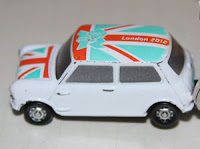 |
| Official souvenir of the 2012 Olympics |
The 2012 Olympics offer an unprecedented amount of coverage,
with programming running almost around the clock on several television
channels. In addition, fans can keep up online and with apps for smartphones
and tablets. As the media scrambles to keep our attention, they continue
to churn out obscure facts about London, the Olympics and specific athletes. Following
is a list of some of the oddest and most interesting things I have learned during the first week of the Games. I'm not sure if it's all true, but it's what I've heard.
- The London Tube is the oldest subway system in the world, dating back to the mid-1800s. It’s been around so long that a species of mosquito unique to the Tube has had time to evolve.
- London taxi drivers have to memorize the location of all of the streets and landmarks in the city, and they must pass a test to qualify for the job. The pass rate is only 50 percent.
- While tea is the most popular drink in England, with 156 million cups consumed per day, it was such a rare commodity in the 17th century that servants weren't permitted to touch it. The Brits give credit to the Duchess of Bedford for giving birth to the ritual of afternoon tea, but claim that the requirement of extending the pinkie is a myth.
- The Olympic medals are stored in a vault in the Tower of London until they are awarded to the winners of each event. Legend has it that if the ravens leave the grounds of the Tower of London, the white tower will crumble, and the monarchy will fall. Therefore, London’s most popular tourist attraction is required to have six ravens on hand at all times. There are also two backups in case something happens to the official birds. A group of ravens is called an unkindness, not a flock. The opponents of Baltimore’s football team probably consider this an appropriate name.
- Michael Phelps consumes 12,000 calories per day. That’s six times the recommended rate for the average man.
- London is hosting the Olympics for the third time, but Queen Elizabeth’s grand entrance in 2012 marked the first time she has attended the opening ceremonies.
- In another first, Wimbledon will not enforce the rule that tennis players wear predominantly white during the Olympics. Showing her true colors, Venus Williams is sporting a patriotic hairdo with red, white and blue braids.
- While, the governments of most countries fund the athletes who participate in the Olympics, the American government does not.
- The men and women who marched under the sign of Independent Olympic Athletes in the parade of nations at the opening ceremonies come from the former Netherlands Antilles and the newly formed South Sudan.
- While I can’t verify that volleyball is the only Olympic sport that has cheerleaders, I have not seen them at any other event in London, nor have I noticed them at a previous Olympics. Along the same lines, beach volleyball matches now feature dancers.
- Horses that participate in the equestrian events must have a passport and a microchip to travel. The American team’s horses were placed in huge containers and flown to London in FedEx planes.
- The marathon has been one of the most well-known events since the Olympics began, but the women’s event was not introduced until 1984.
- The Australian flag is red, white and blue, but the country’s athletes normally wear green and gold uniforms. The Australian athletic community adopted these colors after its country’s cricket team wore them during a British tour in 1899. Green and gold represent the golden wattle, Australia’s national flower, as well as the colors of the landscape.
- The last Olympic gold medals that were made entirely out of gold were awarded in 1912. This year’s medals, designed by British artist David Watkins, are the heaviest and largest in Olympic history.
The following story was not discussed during the Olympics,
but I heard it several months ago, and it stuck with me. At the 1936 Olympics
in Berlin, Jesse Owens famously humiliated Hitler by winning four gold medals.
His roommate Louis Zamperini, although virtually unknown, was also a hero. A
member of the Army Air Corps, his plane was shot down in 1943, and he survived
47 days at sea before becoming a prisoner of war for two years. Captain
Zamperini won several awards for his valor. He wrote “Devil at My Heels” and is the
subject of the book “Unbroken,” both of which tell the story of his remarkable life.
Please share the interesting trivia you have learned during the Olympics.


No comments:
Post a Comment